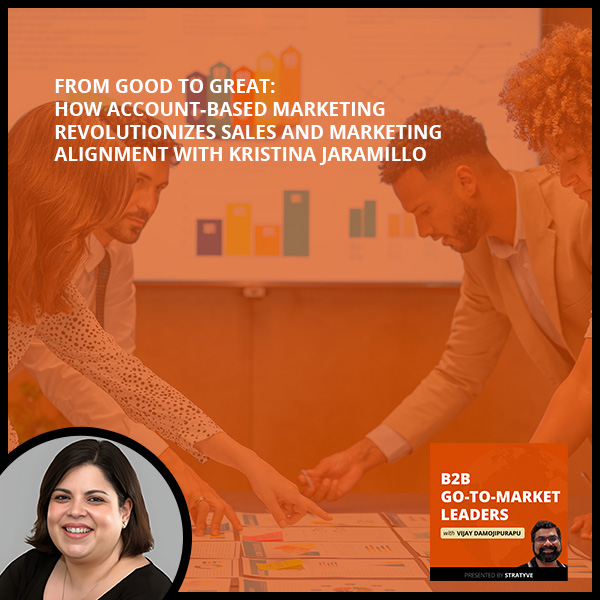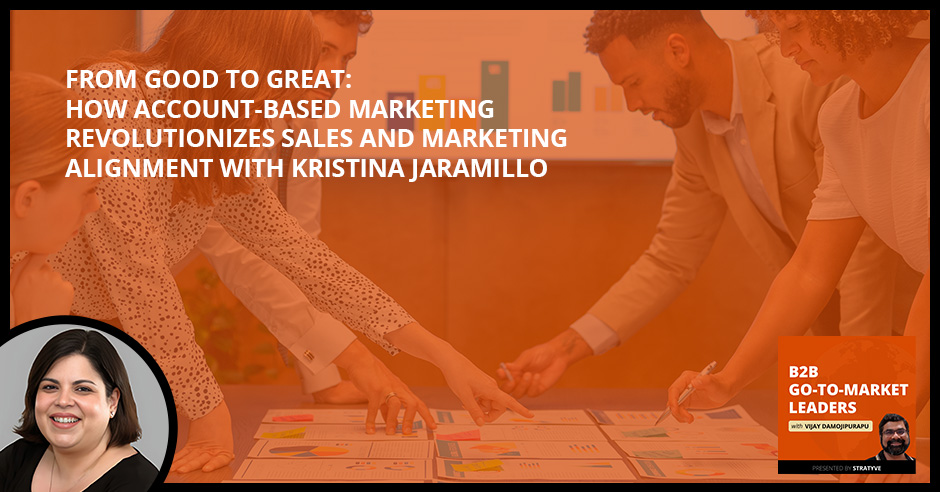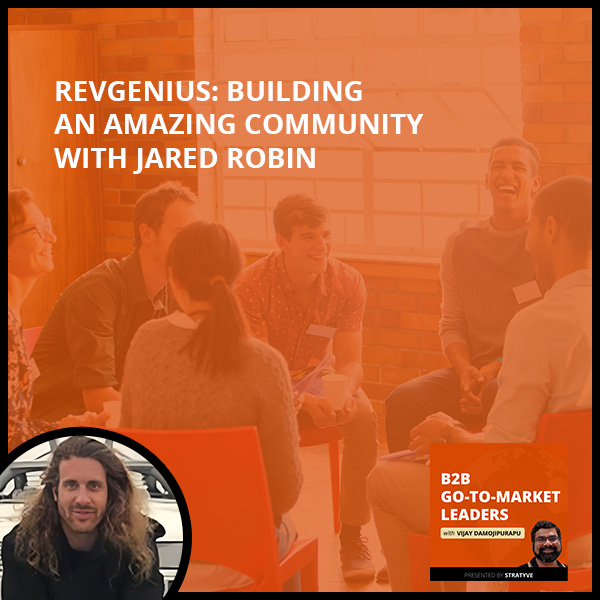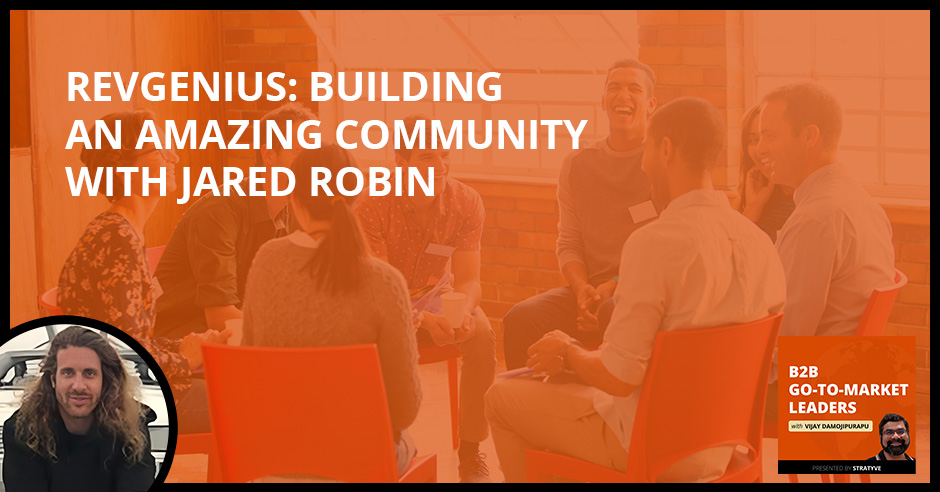

Account-based marketing is the secret weapon that unites sales and marketing. It unlocks unparalleled growth and drives personalized interactions that resonate with clients, leaving generic approaches and missed opportunities far behind. In this episode, we have exceptional marketing strategist Kristina Jaramillo to discuss the world of account-based marketing and its game-changing potential in revolutionizing go-to-market strategies. She highlights the critical role ABM plays in bridging the gap between sales and marketing teams. Drawing from her experiences, she shares how she identifies the ideal personas, the importance of understanding clients’ evolving needs, and how to tailor content for a personalized customer journey. She also reveals the common pitfall of marketing teams falling into a sea of generic messaging, missing the mark on differentiation. Kristina reflects on her go-to-market journey, imparting valuable advice, from the power of challenging the status quo to the art of qualifying prospects efficiently. Tune in now and learn how to seize the ABM advantage!
—
Listen to the podcast here
From Good To Great: How Account-Based Marketing Revolutionizes Sales And Marketing Alignment With Kristina Jaramillo
I’m looking forward to my conversation with Kristina here. Kristina, welcome to the show. I’m looking forward to our engaging conversation around ABM and everything else.
Thank you so much for having me, Vijay. I’m looking forward to it, too as well.
The first question I ask and this is a great conversation starter and my audience loves this, which is, how do you view and define go-to-market?
That is a good question to start off with because everyone has a different take on it. I would say go-to-market is all-encompassing. It’s a step-by-step plan that’s designed for everyone. It’s not just a marketing or a sales thing. It’s how we are going to bring new products, new solutions, any kind of ideas we have as an organization to new customers, existing customers and accounts to drive and capture that demand and eventually revenue.
You touched upon different aspects over here. You’ve touched upon product, marketing, sales, and even customer success. I love the fact that you are pointing out that it’s all of these functions together. That’s what it takes to bring a product or a service to market.
It’s definitely a team sport.
As you and I know, both of us have worked at different companies and with different clients of all various shapes and sizes. Clearly, go-to-market is broken in many ways. One of the things that I’ve seen is a lot of the leadership talk about go-to-market involves all these functions, but when it comes to putting it to practice, that may not be happening for various reasons. For example, marketing finger-pointing to sales and sales doing it the other way around is one example. Also, the other flavor that I’ve seen play out is marketing doing its own thing. Sales is doing its own thing. They may come together, but they don’t bring in products.
I also think it’s different KPIs. When marketing is not focused on revenue, like sales or customer successes, it gets very tricky and it gets messy. That’s why they think the finger-pointing is, but if we’re all on the same page at the end of the day, we want to move revenue or have X goal, then I think that’s much easier for the go-to-market strategy. If we’re saying we want marketing-qualified leads or sales-qualified leads, but revenue is much more concrete and an easier goal to get everyone behind.
When marketing is not focused on revenue, like sales or customer successes, it gets very tricky. It gets messy. Share on XI don’t know how much of it is being put into practice, but at least I’m seeing more and more conversations happening in the social world and with the people I’m talking to, especially with marketing moving away from MQLs as one of the KPIs versus the revenue numbers and even pipeline numbers. That’s more material.
That’s more important. It’s also how we’re improving ARR, GRR, NRR. Everything has to be tied to revenue in some way, shape or form. Otherwise, you’re doing tactics and you’re going through the motions. If it’s not going towards that specific goal of whatever the focus is, if we want to retain, we want to expand, we want net new, whatever that focus is, as an organization, whatever’s more important to them. If you’re not tying back to revenue, you’re going to get lost in the tactics.

I was speaking with another guest right before we hopped onto this and what he mentioned is something that I like and not many people are thinking about this. Go-to-market is always evolving. It does not stay. Go-to-market in the early stage is different from go-to-market at $5 million or $10 million, and go-to-market for one product is different from go-to-market for a different product.
I think we’ve all learned that business leaders, marketers and sales leaders, everything is always evolving. Whether it’s the market, whether it’s our organization or our customers, we have to evolve with them, otherwise, we’re going to get left behind.
Something else that I started seeing, especially because I work a lot with my clients around product marketing and go-to-market, one of the things that I emphasize on is how much of the customer insights are you actually caring about and bringing into the organization. I was in a conversation with a company that was doing $100 million in revenue. When I said, “We need to focus on customer insight,” she was going, “Okay, Vijay, that’s good, but do you really want to talk to customers?” I said, “Yeah, it is customer insights for a reason, so I do want to talk to customers.”
It’s interesting because so many companies will have the value that they believe they’re delivering or their solutions are delivering to the customer, and then the customer will say, “Yeah, we agree,” or “No, we don’t agree.” This is what we actually see that you do for us best. It could change your whole go-to-market strategy if you speak to those customers and say, “We didn’t realize that we were delivering another value that they appreciate even more.”
Switching gears. Can you share with the readers your career story? What got you into where you are now and why did you pick this path, or maybe the path picked you? What is your career journey like?
After school, I did go into corporate. It was working for me. I didn’t like it as much as I wanted to be my own boss. I started on the side, working with a content marketer. He had a content marketing firm and we’ve evolved into a one-to-one ABM. That’s why our organization is called Personal ABM. We focus on those one-to-one interactions. We always noticed through working together that the more relevant we got to the individual, not just their persona, industry, or company, the better the conversation was, whether that was around the marketing side of the conversation or the sales side.
The more relevant and personal we got to that per individual than the buying committee, the better everything went. That’s how we evolved. We went from content marketing to article marketing to social marketing with LinkedIn. We noticed that LinkedIn was the best platform for B2B. We’ve always done B2B. That’s how we’ve gotten to where we are. The more relevant and personal we can get, the better.
The more relevant and personal we can get, the better. Share on XWhat is the rationale or thought process behind naming your company Personal ABM?
For people that are familiar with ABM, the three buckets of ABM, there’s one-to-one, one-to-few and one-to-many. We focus strictly on the one-to-one. We are working with clients that have contract values of at least 100K-plus, even into the multimillion contracts. These are deals that are not going to happen in 2 weeks or 30 days. There are 3, 6 and sometimes 18-month selling cycles. These clients, the prospects that they’re going after need that more personal attention, hence the personal relevance and the Personal ABM side of it. ABM has been defined by the tech that’s involved with it. What’s been synonymous with ABM has been ABM tech and we are the opposite of that.
For us, ABM tech can feed into your one-to-one approach. It’s almost like ABM Tech has made account-based demand gen. It hasn’t been account-based selling, marketing or account-based experiences being delivered. Once you automate it, it’s very hard to get as personal and relevant. I’m not talking, “Vijay fits this role in this organization.” I’m talking about what’s important to him in his role, not as just a marketing leader.
By the way, I’m a big believer in personalized and doing things that don’t scale because at the end of the day, that’s what matters. I want to double-click into this thought process and frameworks that you have, if you can share. What type of clients or companies do you engage with?
B2B, obviously, they are typically what we’ve worked with, with people that are on the technology, SaaS, supply chain tech space. They have to have a minimum of $100,000-plus to get the ROI on our programs. An ideal client would say, “We’re using Demandbase. We’re using Terminus. We’re using 6Sense. We might be using all of them, but we are having a problem getting past filling the pipeline. Pipeline, we’re good with. We’re having problems with stage progression, with accelerating sales cycles and with moving them further in their buyer’s journey.”
That’s where we can say, “Do you want to use ABM to accelerate sales cycles? Do you want to use ABM to protect and expand or is it a retention play? Where is the red in the business? Where should we put it into the focus?” That’s how we can figure out where we’re going. They have a defined need. They’re using tech. It’s not working for them to get everything they want as far as they want. It’s the next evolution of using the tech to go back and see, “What are those interactions that we’re having? What are those experiences that we’re delivering? How can we improve them so that we can apply those learnings to the one-to-few and one-to-many?”
This is super helpful because I’ve seen companies that operate in, “Do you want to set up an ABM program? We can do that right from the processes of frameworks, the teams that you need to have in place, which ABM tech to select, install, and onboard the folks on?” That’s just one other piece. That’s an entirely different piece versus what you’re focusing on. You and your team are focusing on, “You got an ABM program running, you got those ABM platforms that are running, but for some reason, your ABM programs and campaigns that you have been running is not penetrating in account ABC or region ABC.”
You’re not getting the maximum ROI. These are the bigger players that you want to push through the funnel. Maybe they engage for some reason or at one point and they went cold. We have to figure out what is it that happened. Is there an internal strategic priority that we need to better align with for them to get that conversation moving?
What do you see that are typical “problems” or barriers? Clearly, they got to the point that this ABM team has been running. They developed and designed the program and campaign in a certain way. They got some traction with some of the folks within that specific account, but some things happened. There was some sort of barriers to why people were not engaging anymore. From your viewpoint and experience, what do you see as those barriers?
It’s because they were telling everyone’s story with that client. Let me give you an example. We were working with a conversational AI company called Uniphore. They were trying to penetrate a with AI particular bank that was one of the largest players. If I said the name, you’d be like, “Okay.” They were sharing content, messaging, and articles with them on the importance of AI, but it wasn’t working for them because we did a little research and we found out that this particular bank had already developed their own AI internally.
They were sharing the wrong kind of messaging and the wrong kind of content with them. We switched the conversation away from the use of the need for AI in their call centers, as opposed to how can we optimize it? How can we better improve it? How can we layer this solution on top of what you’ve already done to achieve X, Y, and Z? That’s a very different conversation than brand awareness, generic thought leadership, and things like that.
It comes back to Marketing 101. It boils down to what phase or what stage your buyer is in. Clearly, in this case, the bank knows about AI, versus this company was trying to educate and sell them about AI, which was like night and day. There’s a gap right there. You can clearly see the reason why they did not engage any further. You and your team did some digging around and found that that’s not the type of content you should be putting out versus it’s more about educating. “Yes, you guys know the value of AI in support or contact center teams, but this is why you need to talk to us, this company.”
“These are the gaps that we see in your current processes. This is where we see room for improvement and optimization.” You’re coming to the table saying that you understand their organization and their issues as opposed to blanketing them or putting them in the same pile of, they’re a bank. They have this issue.
For me, it pains me a lot because ABM stands for Account-Based Marketing, which means you should be knowing that account inside out, but clearly that’s not the case.
No, because I think a lot of people rush into ABM and say, “Let’s retrofit what we’re already doing into our existing processes, existing systems, and put in the tool, slap it in, and it’s going to run the same way we’ve been doing it. They’re not changing interactions. You’re not changing experiences. You’re not as focused.
Going back to that becoming targeted demand gen. It’s moving away from what it could be. That’s why I think it should be account-based revenue. How are we going to, as a team, get to revenue for this account? What is that going to look like? What kind of play, campaign and content messaging? What does sales need to do? What kind of enablement do we need as a whole to move that account forward?
Hence, why this one-to-one personal approach has to be for your biggest ticket clients or prospective clients because it’s labor intensive, a lot of research needed and a lot of moving parts to get going. It’s one of those parts of ABM that it depends if it fits your organization because one-to-one to other organizations might be, “We have a customized landing page for X, Y, Z company. We’re doing one-to-one.” That’s not the flavor of ABM that we do, but that might work for someone who maybe has a $10,000 solution.

It’s almost like an automated campaign even. It’s at an account level. You cannot do a landing page-type campaign with a true ABM client or situation. In this case, especially if it’s like $100,000-plus deal, a campaign go to check out this landing page, click, and say, “Click to talk to sales will not work.”
If it does work, it’s going to be few and far between, and you’ll have to do it hundreds and hundreds of times to even. You’re wasting your time if you want to close that one account or a couple of accounts that look like that. You could take those learnings and then scale that way. I think people jump into it and scale right away instead of slowing down and stepping back and say, “How can we scale this effectively, efficiently, and slowly so that we’re setting ourselves up for success in the long run as opposed to just getting it out there and getting it started and launching it right away?”
Clearly, you’ve uncovered a major pain point when it comes to executing ABM. Let’s go back to the earlier part of your days when you started Personal ABM, your own company. Earlier, you were developing content and then social media, but somehow you identified this gap within. There’s a pain point and people are willing to pay for it when it comes to personal ABM. Walk us through that journey. How did they arrive at that point?
It’s interesting because we were typically engaging with marketers in the beginning, and they’re like, “The strategies you guys are putting together are for specific selling conversations. We realized that there was that gap. Typically, we’ve seen that marketing is brand awareness, lead gen, PR communications and things like that.
We were in the marketing place of specifically helping a sales team, maybe senior sales leaders depending on the organization because of the size of the deal with their enterprise accounts or their bigger accounts. We are marketing for selling conversations. I know it sounds interesting and odd because you feel like marketing should be for selling, but it’s not always. It’s usually automation, brands, and campaigns. We are kind of the opposite of that.
Initially, with your account marketing, your clients and personnels were in the marketing team and function, but then you figured out your ideal or evolved persona is more in the sales, like account executive or regional sales manager.
It’s interesting. Sometimes it’s even product marketing, VPs of sales, sales enablement because we’re doing that bespoke work for them. It’s not necessarily this is beyond BDRs and AEs. It’s way from that demand gen side or lead gen side.
Going back to what my audience loves about this show and what they look forward to is a go-to-market success story and a go-to-market failure story. If you can walk us through a go-to-market success story first. It is your choice. You can walk us through the failure first.
Let’s do success stories first. I have to give you a little bit of background, so bear with me. We were working with leadership at a UK ITSM analytics firm. They were a SaaS. They were trying to create a new category for them. It was Capacity Planning as a Service or CPaaS. They were looking to become an international player, but they hired a research firm. The research firm said that they would have to break out of their finance niche category because they were known in the financial industry, so they had a lot of work to do.
They needed to create demand for a new product and a new category into new markets. They’re basically almost starting from scratch. They brought on a PR team, drove awareness for that category, invested in intent platform. They had 6Sense, Demandbase for ABM and intent. They were driving awareness pipeline growth but limited stage progression and revenue improvement. Something that I talked about earlier is that we’re filling the pipeline but not getting any further.
We noticed that they had tried to retrofit the lead process they had. They were trying to plug and play the technology instead of building that foundation to see stronger revenue growth for ABM. There was that handoff between sales and marketing versus, “How are we going to work together? How are we going to align and orchestrate as a team?” They were missing the fact that ABM should change that whole selling conversation, changing the sales process, the motions, and the interactions.
We noticed that they didn’t have that content to support the selling conversation. Most importantly, they didn’t have the content to support internal selling conversations. After they’ve done all they can with a demo or whatever it is and shared all their content, what’s going on behind closed doors and how can we support them?
They had defined their ICP, but they didn’t segment that ICP. They treated all those opportunities the same. They gave everyone the same attention, focus, and approach, no matter if they were tier 1, 2, or 3, so we had to adjust that. There was also no strategy for how the go-to-market teams were going to use that intent to engage in closing those in-market accounts that were identified by 6Sense.
They had a lot of activities and cadences, but there wasn’t coordination. That’s how it boils down to sales and marketing coordination. How are we going to work together? They also lacked a strategy for organizations that were stuck in the status quo. These are the organizations that weren’t responsive to their campaigns, accounts that maybe showed previous engagement but disengaged for whatever reason, stuck in the buying journey. We noticed it was because they didn’t see that differentiation to create a buying consensus. That’s why it’s so important to make sure that you can create that internal buying consensus.
We did a little bit of research. We spoke to the sales and go-to-marketed teams. We realized that a lot of the companies that they were targeting outside of their niche or financial industry didn’t understand their tool or how capacity planning would actually help their organization. There was a lot of education they still needed to do. They didn’t see how it would impact the team internally, the business, P&L and how it would impact their infrastructure and visibility gaps within the organization with their IT processes. How does it impact homegrown tech they were already using?

We had to make sure that we were changing that sales conversation to see how the business issues were related and how this tool could fit them. In order to drive growth, we came to the realization that we needed to slow them down to speed them up. We had to get that strategy right before they actually tried to go-to-market as successfully as they wanted to.
What we did was made sure to increase their relevance across all channels. That’s LinkedIn profiles, content they’re sharing and messaging specific to decision-makers that the teams wanted to connect with. We also changed the sales and marketing motions across the buyer’s journey to make sure they were progressing towards revenue. We made sure that the sales and marketing conversations were fully aligned, because a lot of times, marketing might say one thing in their messaging and the selling conversation might be something else.
We needed to take those calculated steps together. We took that personal account-based approach and we aligned with the customer’s needs, their business as a whole, their needs for whatever they wanted to do as an organization for the next couple of years so that we can improve the interactions and then further scale.
Just because this ITSM changed the focus on improving those interactions in the buyer’s journey, they were actually acquired by another group. We played a role in that because, before the acquisition, they were able to gain customers like JCPenny, GoDaddy, British Airways. Now, they were acquired by a larger group that had worldwide reach and this particular organization was based strictly in the UK.
Let’s double-click. There are so many points that we can dive deep into. The first thing is, what prompted them to reach out to you? Did they reach out to you or you found them?
I think we engaged them. We engaged them because we noticed that they sounded the same as everyone. A lot of ITSM firms sound the same. I’m not sure if this’ll resonate with you, but it’s all about better people, better process, better technology, whatever that actually means. It’s very vague to me. I don’t understand what that means. I need it spelled out. We noticed that they were not standing out from their competition. That was how we opened up the conversation with them.
You reached out to maybe their sales leader or a marketing leader?
In this particular organization, it was the marketing leader, and then we were brought in to work with sales as well.
How did you structure the engagement? Based on what you mentioned, it sounds like you had to do the account research and audit and research. That was the first piece, and then identify the content gaps, and then deliver that piece of content, enable and train the account teams.
That’s why we worked with the marketing team first to identify the gaps. We created some of the content as well to fill in those gaps. We then showed them how to use it in the one-to-one conversations. They then were able to do it in the one-to-few and one-to-many. When they started doing campaigns and they could improve those interactions based on the content, based on the messaging and positioning.
You created the template and playbook for the one-to-one, which they could then use it for the one-to-few and one-to-many.
Yes.
How long was the engagement? How long did it take for them to start seeing the ball rolling in the early results?
For them, it was 3 to 6 months, but we wound up working for them up until they got acquired. We were working with them for about three years, and then the acquisition changed everything. Yeah, 3 to 6 months, and then they started realizing. A lot of change management goes into this because marketing is so focused on campaigns, scaling, and automation that you have to retrain to think a different way.
Marketing is so focused on campaigns and scaling and automation that you have to retrain to think a different way. Share on XWhen you’re creating a new category or creating a new market with a new tool that nobody knows about, it takes a lot of teams to do. They worked internally on brand awareness. We worked on getting the larger deals that we knew that they had engaged with but needed a little more support in order to get the sales conversation moving.
What I like about this is the retraining. It is a fact that you need to give personal attention to doing the account research and doing things that once scale in this case. Versus marketing and sales are so trained and the mindset is so wide into doing things that scale and automate.
I’m not saying don’t do them. I’m just saying you have to do this as well as a supplement to optimize them. We talked about it earlier, evolving. Marketing is always evolving. This is a way to evolve it and make it better.
Especially in your case. I’ve seen this play out where a marketing team or sales team realize that whatever they’re doing, they have been doing is not getting the results. They need to bring in someone from an external place, like an external team and augment their internal teams. That’s what played out over here. You mentioned that engagement was for about three years.
We did work with them for a while. Yeah, three years.
Very impressive. That’s a very long engagement.
It was a complicated platform because I had to get my mind around what capacity planning as a service was and why it was so important, so I had a lot of education on my side as well. Once they were having sales conversations with bigger organizations, it made it very exciting on my end because I knew what we were doing was working, so it’s one of my favorite clients and one of my favorite stories because of it.
I think we touched upon so many points there in your GTM success story. A lot of foundation fundamentals, as well as what is missing in the marketing and sales team and why they need a very Personal ABM touch. That was a great piece. On the flip side, as you and I know, it’s not always success all the time. Walk us through a recent GTM failure story.
I have a couple of them. There’s the one that we were talking about earlier about the conversational AI. They weren’t aligning with gaps, but let’s talk about Digisuite. They came to us. They were looking to get a stronger pipeline growth from their existing ABM accounts because they wanted to fuel 4x growth over a 4-year period. That’s what the leadership team had come to a goal for them. After we started looking at the business, we saw that the real issues didn’t lie with the pipeline. They thought it was a pipeline issue. We realized it wasn’t.
It was that they were facing heavy discounting because they were going up to competing with people or organizations like Binder. They were continually losing enterprise deals to trusted legacy platforms. In their case, it was Sitecore and Adobe. They were basically getting squeezed for their deal cycles. We took a lot deeper dive. We noticed that the go-to-market teams were focusing their conversation on pain points that were similar to their competitors. They were not able to drive engagement across the organization.
They sounded very identical to competitors and they failed to teach, to differentiate, and to show where there were gaps in their competitors like Binder. There were gaps in legacy platforms or other competitors that they had that didn’t integrate like they did to integrate across the organization as opposed to being just maybe a marketing tool because they were a digital asset management organization. A lot of organizations are using these particular tools or dams in marketing, but there are other ways that they can be used. They weren’t showing the gaps and the impacts across marketing, across advertising, PR, their eCommerce and sales operation.
There were at least a dozen ways that the organizations could have been leveraging this tool that our client wasn’t discussing. We changed the conversation. We changed the interactions and the account experiences where those sales and marketing were making sure to come to each touchpoint, each interaction, whether that’s face-to-face, digital, email, phone or however they were interacting with a point of view about their prospects business.
What’s going on internally, just because we changed those conversations, they were able to increase their new logo ARR by 55%. They had two times increase in deal sizes and over 100% growth in expansion in ARR, because they were differentiating themselves and changing the conversation to see how they could impact the whole organization instead of a small department within that organization.
A recurring pattern that I’m seeing and hearing is, a lot of times, the marketing teams or these companies, the product marketing, it might be product marketing or other functions within marketing, the messaging is not differentiating versus the competitors. That’s one thing I’ve seen. That’s what stood out for me as you’re sharing this story.
In the prior case study, for me, what stood out is they did not identify or do the research around what type of content will resonate with the specific account. It boils down to what I mentioned, which is customer insights and, for whatever reason, either the product team, marketing team, or maybe even the sales team. The sales team, to some lesser extent, they do not stay in touch or they’re not very close to their prospects or customers for some reason. That is a gap that you guys are filling for them.
Yes, absolutely. We also noticed that one of our clients that we brought on, they had aggressive growth goals for 2030. I think their leadership came to them and said they want to reach $1 billion market share by 2030. They had an ABM program in place. They were using another firm, but they were still missing quarterly and yearly goals.
What we noticed was that the teams were engaging with the low-level users of their solution versus the VPs, the decision-makers, and the C-suite. They were having a conversation around regional conversation or regional discussion versus national discussion or how we can help the whole organization, not just one particular area.
They didn’t have the right KPIs, processes, or contents in place to engage those VPs, COOs, or CFOs who manage the budget for the whole organization and how they will impact the whole organization. That’s another thing that we’ve noticed. They’re having conversations across clients that we worked with about how the solution will fit or play into one area as opposed to what the solution will impact more than the one department or more than the one goal the organization is trying to achieve. You have a different conversation when you can say, “We’re going to impact these five things,” versus just the one.
It goes back to thinking about and building a successful go-to-market playbook. When you’re targeting users, it’s more like a PLG approach, versus if you’re targeting the higher-ups, like the VPs, the C-level suite, it’s definitely ABM, especially if the deal size is in the $50,000 or even $100,000-plus range.
There are bigger buying teams. We all noticed. As the last couple of years have shown, they’re getting bigger and bigger. CFOs are on deals we’ve seen with clients who have never been on the deal before. We have to make sure that we’re speaking their language, talking to what’s important to them, and how we can fill those gaps for them so that they have a stronger incentive to buy.

How do you approach your clients? What I’m hearing is a recurring pattern over here. You close the gap or you start off with customer research doing primary interviews and then uncover what content is relevant at that specific account or the team, and then create that account. You don’t just stop at account level. It’s more about using this account, how you integrate, and you start tracking that in ABM and CRM platforms across the board. How do you find your clients and what kind of services do you offer across the board?
Typically, we want to make sure that the client has a certain solution price point if we can figure that out. We also want to see what kind of technologies they’re using. Are they evolving their ABM approach or is ABM not even on the radar for them because then we have to do too much education and it would take too long? As well as we see that they got funding to fuel a particular growth. Are they trying to leverage into a new market? Are they trying to new regions of the world? What is that funding being used for? Is it being used for sales and marketing? We can speak to that and be more relevant that way.
It has to be, maybe they showed intent, whether they attended one of our webinars or one of our podcasts or things like that. It has to be a couple of things that trigger the event. We then do a little research of how our solution can fit into them. We’re constantly looking for ways to disqualify prospects only because we know that our solution is not for everyone. It’s not going to fit for everyone and the conversation will make sense for everyone.
We offer a couple of things. We do account-based intelligence and enablement. I was mentioning earlier how one of our clients was targeting banks. We did research on the particular named bank, not just banks that fit the criteria and fit the ICP. We will do account research for them so that they make sure they’re addressing what’s going on internally.
We also have one-to-one services. If you know that you’ve identified these couple of dozen accounts that are engaged or went dark for whatever reason and we need help to progress the deal, then that’s something we can help as well. We also have account-based enablement, accounts-based intelligence, the one-to-one. That’s the three ways that we play. We just revamped the website, so I’m trying to figure it out.
In a nutshell, that’s what I was getting at. We talk about other companies or other clients’ go-to-market. Versus now, we articulated your go-to-market. What stood out for me is that you first of all have a clear ICP criteria, do your account research, and are present on different channels, podcast or LinkedIn or webinar, and other events. You qualify and disqualify whether you need to have a further conversation.
I try to do it as quickly as possible only because I’ve learned the hard way.
This is something that I am learning as well. I know we are getting more into our personal territories, but the best salespeople, I’ve been studying them. They are very quick at disqualifying opportunities.
They have to stay hyper-focused.
I know we are coming towards the end of the conversation. Let’s switch gears over a bit. If you could turn back time and go back to day one of your go-to-market journeys, what advice would you give to your younger self?
This piece of advice would actually probably apply to personal and business, but speed up to slow down. A lot of organizations are trying to scale and I understand the need, but they’re also forgetting that they’re going to scale with wrong interactions and wrong experiences, so they’re not having the desirable impact.
If we can take a step back, then we can scale correctly and more efficiently as opposed to having to go back to the drawing board and saying, “We scaled right away, but all the messaging was wrong, so now we have to start all over again.” You might not realize that until a couple of years down the line when it might be either too late, depending on your organization, or require way more work because you’ve been at that particular framework for so long.
The final question before we wrap this up is, what would you call out as your wanted superpower or skills? What do people approach you for around go-to-market?
I would say that I am a big believer of the challenger sales, so I am a challenging status quo. I would say a lot of things on LinkedIn, on my podcast, in my writing that maybe goes against marketing 101. I’m not a big believer in campaigns. I know that they’re a necessity, but I go against that. I think people would say that I stand out for that.
Also, being a woman business owner and being in business for over ten years and having this business is something that’s not as common. In marketing, I’ve seen the men and women, but I haven’t seen as many marketing firm leaders in the female aspect. I would say those 1 or 2 superpowers. Also, the fact that I’m a multitasker because I’m a mom, but that comes with the territory.
Thank you for our wonderful conversation, Kristina. I totally enjoyed our conversation around ABM, what you bring to the clients, and what you do around go-to-market. Kudos. Good luck to you and your team.
Thank you so much, Vijay. I appreciate it.
Important Links
Love the show? Subscribe, rate, review, and share! http://stratyve.com/






